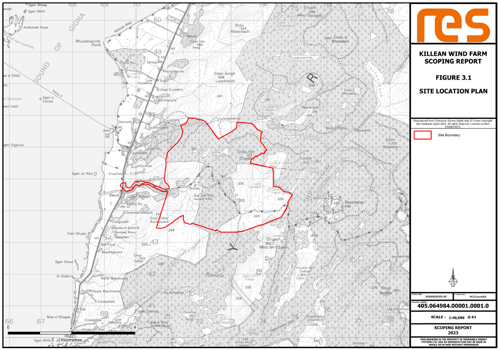About the project
The proposed Killean Wind Farm is located approximately 2km east of Tayinloan, Argyll and Bute.
The site is currently utilised as commercial forestry plantation and open rough grazing for livestock. It has good wind resource and lies outside any nationally designated landscape areas.
In August 2023 we submitted a Scoping Report to the Scottish Government, seeking feedback from them and other key consultees on the scope of the proposed Environmental Impact Assessment (EIA) survey work. This report included an early design layout of up 12 turbines with a maximum tip height of 180m. The scoping report can be viewed at Scottish Government's Energy Consents Unit (ECU) website at energyconsents.scot.
Following our public consultations in November 2023 and March 2024, as well as, the outcome of further environmental and technical studies, we subsequently reduced the number of proposed turbines from 12 to 9. The revised design has an overall installed site generating capacity of 59.4MW, enough to power around 51,000 homes1 with clean, low cost electricity, every year.
Reducing the number of turbines has allowed us to reposition those remaining to achieve a more compact layout, while reducing the risk of conflict with geese flight paths. Our peat depth surveys have also allowed us to ensure that the site tracks, hard standings and substation location, avoid peat deeper than 1m as far as possible.
Environmental Impact Assessment
As part of the planning process, RES undertook an Environmental Impact Assessment (EIA). The purpose of an EIA is to investigate and alleviate any potential effects of a development on the natural, physical and human environment. An EIA includes the following assessments:
- Landscape & visual
- Ornithology
- Ecology
- Archaeology & cultural heritage
- Hydrology, hydrogeology & geology
- Traffic & transport
- Noise
- Socioeconomics
The results of these surveys can be found in the extensive Environmental Impact Assessment Report (EIAR) which forms part of the planning application which was submitted in August 2024. For more information, please click here.
The need for onshore wind
We facing a climate emergency, and at the same time seeking to enhance the security of our energy supply. Onshore wind can address both of these.
This is recognised by the Scottish Government’s National Planning Framework 4 (NPF4), Scotland’s long term spatial planning strategy, which was published in February 2023. Scotland currently has almost 9GW of operational onshore wind capacity. The Scottish Government has a target of achieving 20GW of installed wind capacity across Scotland by 2030 in order to help meet Scotland's legally-binding 2045 ‘net zero’ carbon emissions target. This is a substantial increase in capacity and will require a significant deployment of new onshore wind projects in order to meet the demand for green, low carbon electricity - which is not only essential for tackling climate change but also for supporting a globally competitive economy and creating jobs.
Onshore wind alongside other renewable technologies can generate the cheapest form of new electricity generation. It also increases energy security by reducing our reliance on imports as well as building our resilience to sudden price fluctuations and the uncertainty of global markets. Killean Wind Farm would be capable of generating enough clean, low-cost electricity for around 51,000 homes and reducing carbon emissions by approximately 47,145 tonnes each year based on a grid-mix of fossil fuel, nuclear and renewable generation. Onshore wind is also quick to build (12-24 months) and the carbon payback time is usually within 1-3 years – with the Killean Wind Farm proposal expected to achieve carbon payback within 1.9 years.
Planning submission
In August 2024, RES submitted a section 36 application for consent to Scottish Ministers for Killean Wind Farm. The application was accompanied by other key documentation, including the Environmental Impact Assessment Report (EIAR). The view the planning application and associated documentation, please click here.
1 The 51,000 homes equivalent figure has been calculated by taking the predicted annual electricity generation of the site (using the Department for Energy Security and Net Zero (DESNZ) long-term average load factor for [onshore and offshore] wind of 32.08% and RES’ predicted site generation capacity of 59.4MW) and dividing this by the annual average electricity figures from DESNZ showing that the annual GB average domestic household consumption is 3,239 kWh (January 2024). Final wind farm capacity will vary depending on the outcome of planning permission and the turbine type selected.

